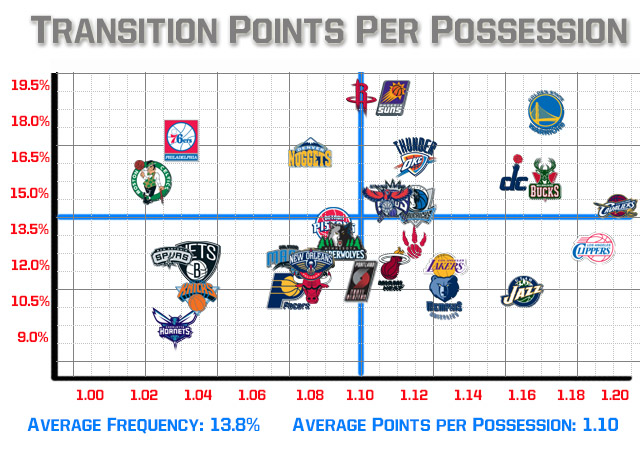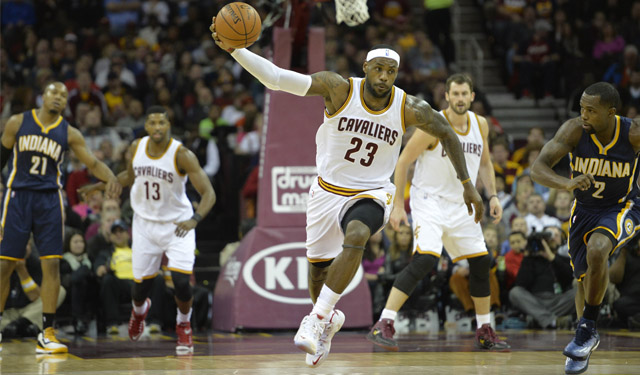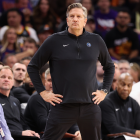Pace in the NBA is a tricky thing.
For coaches, understanding the lineup limitations of the talent on your roster is huge. If you're on the short end of the stick when it comes to the talent on the floor in any given game, you want to limit possessions so your disadvantage can't be exploited as often. If you're sure you're going to have superior talent most nights, it behooves you to push the pace of the game to get as many possessions as possible.
However, pace doesn't just mean a team is playing a fast brand of basketball. And it doesn't always mean you're a responsible offensive juggernaut choosing to overwhelm the opponent with the speed of the game. A lot of pace is born out of sloppiness with extra possessions being created by a high rate of turning the ball over. Of the 10 fastest teams in the league, five of those teams (Rockets, Suns, Sixers, Kings, and Timberwolves) are in the bottom 10 in turnover rate.
While it appears they have great pace to the game, they're really just giving the ball to the other team far too often. It creates chaos but it's as much chaos for their own side of the game as it is for the opponent. Not all pace is created equal. Figuring which teams run the best as opposed to which teams have the most possessions is a much better measurement of how pace is implemented into game plans.
Who are the most effective teams when it comes to pushing the ball in transition? Do those teams push the ball enough or are they leaving potentially efficient scoring chances on the table by not trying to get out and run more often? Finding the balance between opportunistic transition opportunities and trying to create constant transition opportunities can be tricky.
The Cleveland Cavaliers are the best in the league when it comes to transition scoring efficiency. They score 1.20 points per possession in transition opportunities, according to NBA.com/stats, and are trailed by the Los Angeles Clippers (1.19), Golden State Warriors (1.17), and Milwaukee Bucks (1.17), respectively. The Cavs are slightly above the league average in frequency of transition possessions, while the Warriors and Bucks are over comfortably and the Clippers are under league average.
The Houston Rockets run the most in the NBA with 18.7 percent of their offensive possessions ending in a shot, free throw attempt, or turnover. The Phoenix Suns and Warriors are tied for second at 18.6 percent. The Warriors are the most efficient of these three teams, while the Suns are slightly above league average and the Rockets sit right at league average.
So which teams are the best overall at pushing the ball ahead?

There are 10 teams in the NBA that score at least the average points per possession mark of 1.10 while also eclipsing the average frequency of transition possessions of 13.8 percent.
Eight of those 10 teams are headed for the playoffs with the Phoenix Suns in pursuit of the 8-seed in the West and the Sacramento Kings mired in another unnecessarily chaotic season. As simple as it sounds, finding ways for quick, easy, efficient points can really lead to success and doing that more frequently can really boost an offense. Seven of those 10 teams are in the upper half of offensive efficiency in the league this season.
THE TEAMS THAT NEED TO RUN MORE
As the Utah Jazz play better during the second half of this season, the defense has looked superb. They've posted the best defensive rating since the All-Star break and have played at the slowest pace despite turning the ball over the second most often. You'd think with being so careless with the ball, they'd manage to find themselves in faster games, but instead they've managed to keep the pace incredible slow. On the entire season, the Jazz are tied for fifth in transition efficiency and yet they're tied for the third slowest frequency.
The Jazz could stand to play with more pace to their game, finding ways to accumulate quick, "cheap" points to boost their middle of the road offense. The problem is their point guard play has been terrible all season long and is especially bad in transition. Rookie Dante Exum only accounts for 6.8 percent of their transition opportunities, and checks in at a well below average efficiency of 1.02 points per possession.
Trey Burke is the real problem in transition. When the big men run the floor and finish the play, the Jazz are unreal. Derrick Favors, Rudy Gobert, Enes Kanter (before he was traded), and Gordon Hayward are all phenomenal in transition.
However, Burke accounts for roughly 16 percent of the opportunities and checks in at a putrid 0.88 PPP in transition. He's one of the seven worst transition scorers in the NBA.
If the Jazz could get better point guard play next season with Burke and/or Exum establishing themselves as real threats on offense, you could see the frequency of pushing the ball and the efficiency of pushing the ball get even higher. In theory, this Jazz team is one average to above average point guard away from being the best transition team in basketball. If they can do that while maintaining a semblance of the second half defense we've seen from them, we could see them leap frog a few teams in the standings next year.
The Los Angeles Clippers are another team that shows incredible efficiency in the open floor, but their infrequent transition game ends up hurting them a bit. It's hard to imagine their offense becoming much more efficient (second in the NBA in offensive rating), but by possibly running more often, we could absolutely see that. The Clippers are the second most efficient running team in the NBA, mostly due to Chris Paul's incredible management of transition and J.J. Redick's 71.4 effective field goal percentage.
This team was second in transition efficiency last season, but only the Rockets, Suns, and Sixers had a higher frequency than the Clippers. This season, the Clippers' efficiency remains relatively unchanged but they're 17th in transition frequency. The majority of that drop-off could be attributed to Blake Griffin's absence in 15 of the 71 games. He's so good at getting out in transition and making plays that it truly changes the game even for a hyper efficient team like the Clippers.
The question for them becomes whether or not they'll be able to run often in the postseason. Working Griffin back into game shape and finding the continuity on the court necessary to be an elite scoring team in the postseason is still in progress. With DeAndre Jordan turning up his already elite defensive rebounding, quick outlets to guards or even Griffin could make Los Angeles even deadlier in transition. They just need to find those opportunities more often like they did last season.
THE MOST OPPORTUNISTIC TEAMS
Of the elite transition scoring teams in the NBA, the Milwaukee Bucks and Dallas Mavericks appear to make the most of forcing a high rate of turnovers. The Bucks are the top team in the NBA at forcing turnovers, getting their opponents to cough it up 17.3 percent of the time. Milwaukee is 15th in the NBA in pace, partially because they're so good at forcing turnovers and they're so bad at protecting the ball (29th). They're stellar at turning those mistakes by the opponent into transition points.
Khris Middleton and Giannis Antetokounmpo have been destructive for opposing transition defenses. Middleton stretches the floor beautifully in transition with his 68.5 effective field goal percentage. He's scoring 1.27 points per possession in transition and is third on the team in opportunities. Antetokounmpo finds freakish ways to score by taking just two dribbles over the course of 47 feet. He's putting in 1.17 points per possession and does things like this after picking off a pass or ripping someone's dribble.
The Mavs have the best balance of not turning the ball over while forcing mistakes by their opponents. They're third in the NBA in turnover rate, giving it up just 13.2 percent of the time, while forcing the third highest turnover rate in the league (16.8 percent). In the process of protecting the ball and forcing turnovers, the Mavericks find ways to turn those opportunities into points.
Dallas is tied for ninth in the NBA in transition efficiency, scoring 1.12 points per possession. Tyson Chandler (1.39 PPP, 10.5 percent frequency), Devin Harris (1.31 PPP, 21.3 percent) and Chandler Parsons (1.24 PPP, 19.8 percent) are devastating to opponents. And Dirk Nowitzki is still a serious threat trailing the transition plays for 3-point shots, scoring 1.15 points per possession and dropping a 55.9 percent eFG.
The one real problem for the Mavericks in transition has been Monta Ellis. He has the highest percentage of transition possessions (19.1 percent) but he scores just 1.04 points per possession. If Monta can become a more efficient scorer in transition when the playoffs come around and not turn the ball over so much, he could end up giving the Mavericks that extra boost on offense.
THE PERFECT RUNNING TEAM
The Warriors might be the most impressive transition team in the league, despite being a lower efficiency compared to Cleveland. Golden State has the most transition points, the third highest efficiency, and they have 4.2 percent more transition possessions than Cleveland does. That's a significant bump in frequency. It's almost impressive because they don't get their points by drawing fouls. They have the fifth lowest free throw frequency in transition in the NBA. The Cavs are 16th in free throw frequency.
What makes the Warriors so good in transition is obviously Stephen Curry. He's the third best transition scorer in the NBA for players with at least 200 possessions, just behind LeBron James and Gordon Hayward. Curry's effectiveness, especially with how he makes every transition opportunity dangerous from 35 feet in, helps open things up for guys like Andre Iguodala and Draymond Green.
Iguodala and Green have combined for 22.3 percent of the transition possessions and 1.17 points per possession. They lead a group of role players for the Warriors that all thrive in transition with Marreese Speights (1.33) and Leandro Barbosa (1.30) both taking advantage of transition opportunities off the bench. The Warriors simply overwhelm you with waves and waves of quick scoring opportunities and because Curry is such a threat and you can't afford to leave Klay Thompson streaking to the wing.
Under Mark Jackson in 2013-14, the Warriors were 18th in the NBA in transition efficiency with 1.11 points per possession. They were 11th in transition frequency. Under Kerr this year, running has become more of a staple of their offense and they've yielded the results to prove it was worth the change.
Perhaps the way the Cavaliers can help themselves out more is by trying to run more often. LeBron James and Kyrie Irving account for over 50.0 percent of the transition possessions by themselves, and have combined for 1.25 points per possession. More outlet passes from Kevin Love passes and shooters like J.R. Smith, James Jones, and even Iman Shumpert can possibly benefit from the Cavs pushing the pace.
When it comes to the postseason, these elite transition teams could end up stealing games and series, as they rack up the quick, efficient scores in key playoff runs. It's a tricky balance to find.






















